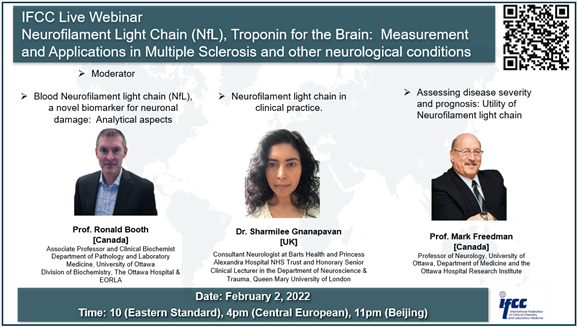
Dear Colleagues,
The next IFCC webinar: "Neurofilament Light Chain (NfL), Troponin for the Brain: Measurement and Applications in Multiple Sclerosis and other neurological conditions" will be held on 2 February, 2022.
Neurofilament light chain (NfL) is a major component of the axonal cytoskeleton and has been identified as a sensitive CSF and blood biomarker of neuronal damage. Recent evidence has shown utility in various conditions including multiple sclerosis (MS), Alzheimer’s disease, Parkinson disease, and amyotrophic lateral sclerosis (ALS). The largest body of evidence has been generated in MS patients with its main utility in prognosis and follow-up, but is of increasing importance in monitoring response to therapy.CSF concentrations of NfL range from a median of 300 pg/mL in healthy individuals to over 6000 in ALS while concentrations in blood are 50 to 100 times lower than CSF and thus require highly sensitive analytical techniques to measure accurately and reliably. The SIMOA single molecule array assay is the most commonly used assay for blood-based NfL measurement and is emerging as the preferred method for clinical use. Our laboratories are early adopters of NfL and are the first clinical diagnostic labs to operate the NfL SIMOA assay for clinical use. In the first portion of the session we will review the methodology, analytical and clinical details from a laboratory perspective. We will discuss the analytical validation, multisite comparison and implementation of appropriate cut-points.The remainder of the session will be focused on utility of NfL in the clinic. MS patients have a clinically variable course with some rapidly progressing while others not and identification and treatment of rapidly progressive patients is important. Annual MRI is used to monitor patients, however has the disadvantages of being expensive, often localized to just the brain and provides only a single assessment timepoint. NfL has the advantage of being inexpensive, monitors damage wherever it may occur in the nervous system (e.g. spinal cord) and can be monitored more frequently. In monitoring patients, NfL can reduce the need for MRI in stable patients and select only those in need of urgent MRI due to significant NfL increases. It also has the potential to identify MS patients at risk of progression and allow for earlier introduction of aggressive therapy. We will present recent data from our various patient cohorts to support the clinical and prognostic utility in various patient groups.
Learning Objectives: At the conclusion of this course, attendees should be able to:
1. Become familiar with techniques to measure neurofilament light chain in blood
2. Understand the role of neurofilament light chain in detecting neuronal damage
3. Recognize the clinical utility of neurofilament light chain in multiple sclerosis and other neurological conditions
Chair/Moderator: Ronald BoothTalk
Talk 1: "Blood Neurofilament light chain (NfL), a novel biomarker for neuronal damage: Analytical aspects" - Ronald Booth
Talk 2. "Neurofilamentlight chain in clinical practice" - Sharmilee Gnanapavan
Talk 3: "Assessing disease severity and prognosis: Utility of Neurofilament light chain" - MarkFreedman
- Schedule: 20 min per speaker plus 20 min panel discussion
- Time Zones: Live presentations starting at: 10:00AM EDT - 12:00PM Buenos Aires- AR; 4:00PM European Time; 8:30PM India; 11:00PM CST-Beijing
Important: Please ensure that you carefully determine the time that the presentation will start in your global time zone. Click here to convert to your time-zone. - Recorded webinar: available on demand
- Certificate of participation: available for all registrants
Register here